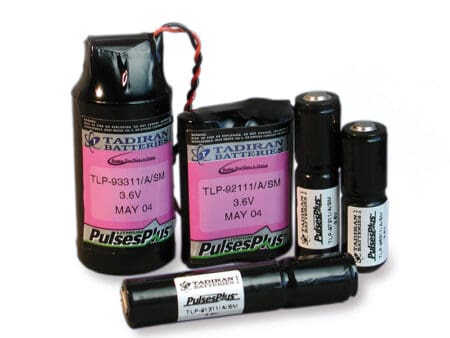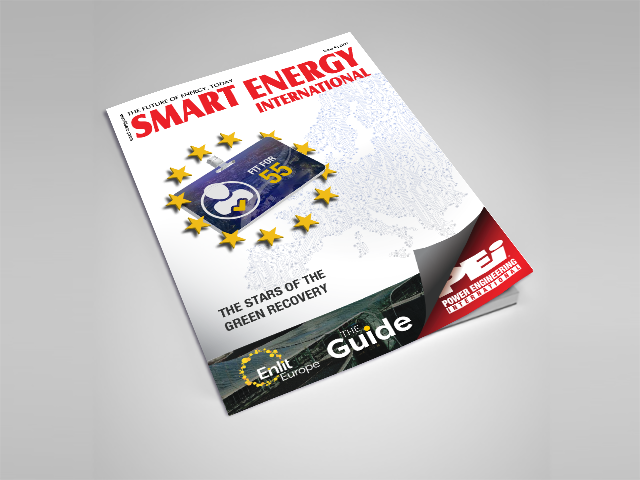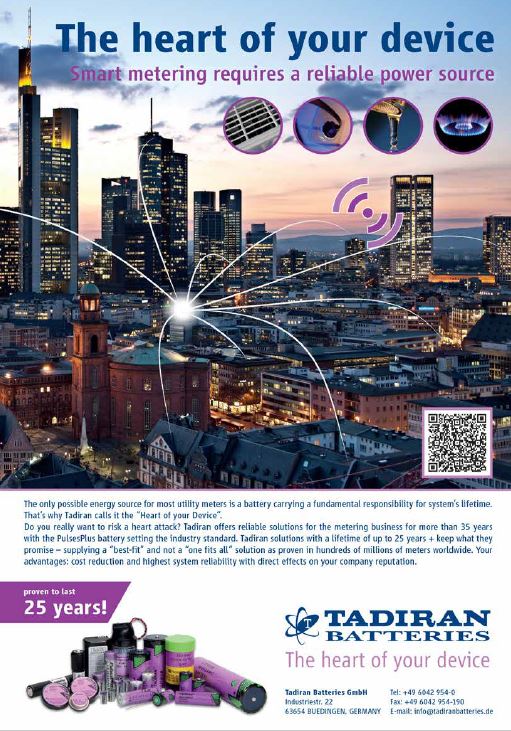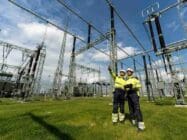
AMR/AMI smart metering systems are being enhanced by smart data driven by artificial intelligence (AI). Meter transmitter units (MTUs) provide forward-looking data intelligence to detect leaks, stop theft, improve customer service, automate billing, create predictive maintenance plans, and preserve natural resources.
These upgraded devices increasingly utilise ultrasonic technology that contains no moving parts to last indefinitely, limited only by the life of the battery. Since these systems cost roughly twice as much as the mechanical meters they replace, the batteries that power them should ideally last more than twice as long as standard lithium batteries.
This article was originally published in Smart Energy International Issue 4-2021.
Read the mobile-friendly digital magazine or subscribe to receive a print copy

Advanced meters rely on bobbin-type LiSOCl2 batteries
Leading AMR/AMI meter manufacturers specify bobbin-type lithium thionyl chloride (LiSOCl2) cells to power ultrasonic MTUs, providing a long-life solution that protects against disruptive system-wide battery failures. Municipalities need to anticipate such possibilities by pre-emptively replacing thousands of batteries each year just to avoid potential chaos, significantly raising their cost of ownership.
Bobbin-type LiSOCl2 batteries are overwhelmingly preferred for low-power applications that draw current measurable in micro-amps. Bobbin-type LiSOCl2 batteries deliver unique performance benefits, including: higher capacity and energy density; the widest possible temperature range (-80°C to 125°C); and extraordinarily low self-discharge.
All batteries experience some amount of self-discharge even when disconnected from an external load. Bobbin-type LiSOCl2 cells feature the lowest self-discharge rate of all, largely due to their unique ability to harness the passivation effect.
Passivation occurs when a thin film of lithium chloride (LiCl) forms on the surface of the lithium anode, thus impeding the chemical reactions that cause battery self-discharge. Whenever a load is placed on the cell, this passivation layer causes high initial resistance and a temporary drop in voltage until the passivation layer begins to dissipate: a process that repeats each time the load is removed.
Cell passivation is influenced by cell capacity, length of storage, storage temperature, and discharge temperature. Partially discharging a cell then removing the load also increases the passivation effect relative to a new battery. Battery self-discharge is also affected by the quality of raw materials and the manufacturing process.
Passivation is essential to extended battery life but too much of it can overly restrict energy flow.
Better cells: better energy retention
A superior quality Bobbin-type LiSOCl2 cell typically loses only 0.7% of its available capacity annually due to self-discharge. By contrast, an inferior quality cell can lose up to 3% of its capacity each year due to self-discharge, thus exhausting 30% of its available capacity every 10 years, which limits its operating life to 10-15 years.
The potential of more than 25-year battery life achieved with Tadiran’s batteries has been validated by various metering and utility companies all over the world.
Continuously random samples are taken after many years operating in the field and are tested, proving to have a significant amount of remaining capacity that will outperform the requirements of the devices.
Advanced AMR/AMI metering devices require high pulse energy
AI-enabled data intelligence requires bidirectional wireless communications, drawing additional amounts of energy. Standard bobbin-type LiSOCl2 batteries are unable to deliver the high pulses needed to power bi-directional wireless communications. This challenge can be overcome with the addition of a patented hybrid layer capacitor (HLC). The standard bobbin-type LiSOCl2 cell delivers low daily background current, while the HLC delivers periodic high pulses to power wireless communications. The patented HLC also provides a measurable end-of-life voltage plateau that can be interpreted to deliver ‘low battery’ status alerts.
By developing its highly powerful PulsesPlusTM battery system combining high energy cells with an HLC which is responsible for delivering high current pulses, Tadiran Batteries has early identified the future need of smart metering for increasingly energetic lithium batteries that can limit self-discharge while also delivering high pulses. Tadiran power source solutions provide decades of reliable energy to enhance data integrity and support a lower cost of ownership.
About the author

Marc Henn studied Mechatronics Engineering near Frankfurt/Main and holds a Master´s degree in Business Administration. After a long-time responsible position in the testing and certification industry he joined Tadiran as Manager of Application Engineering in 2016.
About the company
Tadiran Batteries is a leader in the development of lithium batteries for industrial use. Tadiran Batteries are suitable where utility meters require a single long-term standalone power source even if it has to supply high pulse currents for a GSM module.









